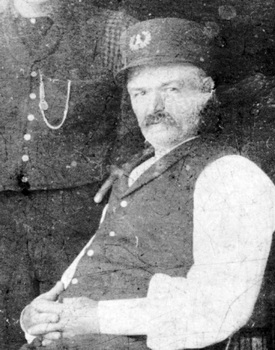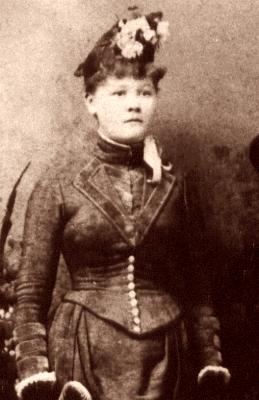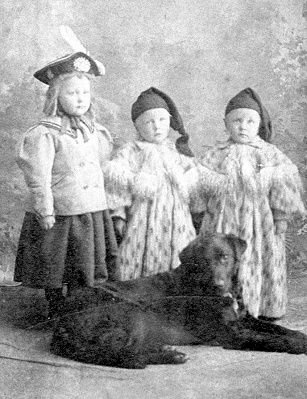| |
The Michigan Island Mystery
Part Two
Back to Part One
There is one mystery at Michigan Island that most of us would much rather not think about. For many years I never spoke of it, but now I realize that the memory of a brave young woman deserves recognition. Writing many years afterward, Edna Lane Sauer spoke of odd circumstances on her family's arrival on the island in 1902:
Early the next morning we went on board the Barker accompanied by Mrs. Brown, the former keeper's wife. We landed on the island to find the living quarters a filthy mess. A horse hide had been tacked to the one bedroom floor and the whole place was overrun with roaches. Mom and Dad had to scrub everything. Mrs Brown said, 'Oh, don't worry about the roaches, you'll never get rid of them.'
 |
Charles Brown, lighthouse keeper
and rapist |
Her account suggests that Keeper Brown’s family left the island in haste, but why? When asked, Edna Sauer was reluctant to say. "I didn't want to clear up the mystery surrounding former Keeper Brown. Not pleasant to write about." However, an article in the Bayfield Press reveals the horrifying explanation:
Charles H. Brown, lighthouse keeper on Michigan Island, was given a term of five years in state prison Thursday on the plea of guilty. Brown, who is 54 years old, stands convicted on his own admission of ruining his 16-year old daughter, the relations between the two having continued for two years.
Two months after her father’s conviction for incest, the keeper’s daughter gave birth to a son. Four years later, she married a young man who raised her child as his own; others followed eventually. I’ve had conversations with one of her grandchildren, who assured me that his grandmother lived a long and contented life, but never talked about her years on Michigan Island.
 |
Anna Carlson:
"The Heroine
of Michigan Island" |
The most famous story involving the Michigan Island lighthouse provides a welcome contrast to the heart-breaking narratives above. It’s not actually a mystery, but it’s filled with suspense nonetheless. At the end of the 1894 navigation season, keeper Robert Carlson and his wife Anna decided to stay on the island for the winter, rather than risk a late November trip on the treacherous lake with three young children – a two-year-old girl and twin infant boys. (Perhaps they had heard of the ordeal of Assistant Keeper J.S. Atkinson’s family, who were forced to throw a kitchen stove overboard in order to survive their 1871 end-of-season journey. Daughter Margaret was five weeks old at the time.)
All went well until one late winter day when Carlson, along with his brother, who served as assistant keeper, decided to go ice fishing. Heading out on a pair of dog sleds, the men made their way offshore, where they harvested a fine catch of trout to supplement the family food supply. However, before they were ready to return, a sudden gale arose, breaking the ice into floes and blowing them out to the open lake. The brothers spent a long night leaping from one cake of ice to another, as the wind drove them farther and farther from the island.
Back at the lighthouse, Anna Carlson had no idea of what was going on. She made supper for the family and waited several hours for the men to appear, finally feeding the children and putting them to bed. Then she sat up and waited as the night passed. At daybreak, she forced herself to confront what seemed inescapable: not only had she lost her husband, but she and her children were marooned in winter on an island in Lake Superior, and no one would even know of their plight until spring. It was up to her to keep her children alive until then. Later on, she told a journalist of her thoughts and fears:
Morning found me on the verge of hysteria. But there was serious work to be done. I had to milk the cow because of the children. And I was afraid of a cow. Raised in Chicago, where one doesn't even think of such things, I had never learned to milk…
I went down to the barn and looked at the cow. She swung her head and made a noise and I knew I could never milk her as I had seen my husband do. Running into the woodshed, I grabbed the ax, and in desperation began chopping at the wall of her manger. Making a hole through which I could put both hands, I started to milk into a little tin cup which I held with one hand, milking with the other.
 |
The Carlson children, a few years later |
Laugh if you will at this scene: audiences always do when I tell this story, and I laugh along. But then stop for a moment of reflection, as I do next: that moment when a desperate young woman found the means to do what she needed for her children strikes me as the single greatest moment of courage in all the tales of the Apostle Islands.
The Carlson’s story has a happy ending: after four harrowing days, the family was reunited. A shift in wind eventually brought the castaways in hopping distance of Madeline Island, where they found an old boat that they could push along the ice, then paddle across the open water. Now, when I look at the Michigan Island lighthouse, the image I picture is not that of the grieving Rumrill family, or the loathsome Charles Brown; I think of that moment when Robert Carlson walked in the door and said, “Anna, I’m home.”
|
|